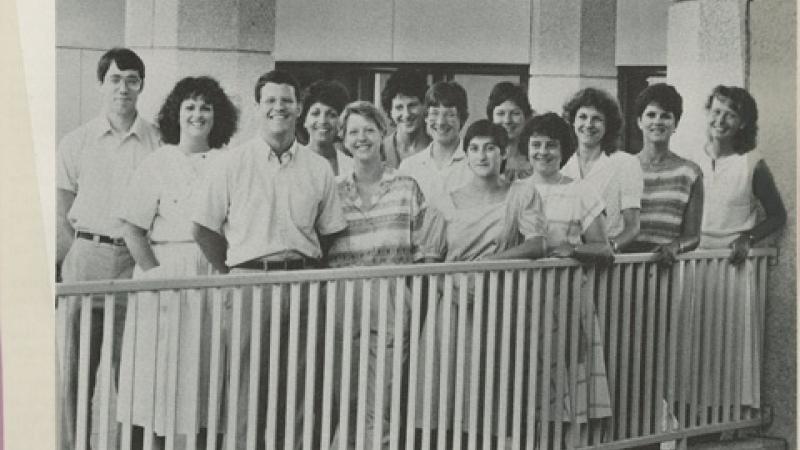
Part 4: Family Medicine at Duke - 'Family medicine is to be phased out'
Editor's Note: This is the fourth in a seven-part series about the history of family medicine at Duke University Medical Center.
Read Part 1 | Read Part 2 | Read Part 3 | Read Part 5 | Read Part 6 | Read Part 7
On April 2, 1985, four days after a memo written by Robert G. Winfree, then-associate vice chancellor for health affairs, detailed how to proceed with the Department of Community and Family Medicine, William Anlyan, M.D., then-chancellor of health affairs for Duke University, told E. Harvey Estes, Jr., M.D., then-chair of the Department of Community and Family Medicine, in a private meeting that family medicine was to be eliminated as a clinical discipline at Duke, adding that other clinical activities of the department would also be eliminated. The phase out would take place over a four-year period to allow all residents currently engaged in training to finish their work.
On April 3, 1985, Estes submitted his letter of resignation as chair of the department.
“As you know,” Estes wrote, “I believe strongly that your decision to phase out Family Medicine at Duke is the wrong one, for Duke, for our students and trainees, and for the community and area. The reason for my decision is that it will be impossible to maintain an acceptable faculty and staff under the ‘lame duck’ conditions which will exist after your announcement.”
Estes concluded by writing, “I wish that you and my fellow chairmen could share our vision of what could have been achieved by working together.” Estes said recently that none of the other clinical chairs ever called him to personally talk about the plans that were being discussed regarding his department.
“All of this was done in an unnecessarily adversarial way,” said Estes, distinguished service professor emeritus. “They would have meetings of all department chairs except our department. You don’t do that. I was never asked to come and defend our department. This all was done behind my back and without talking to me at all. Ever. I’ve never had a meeting with them. Anlyan told me about it later and shared all of his problems in trying to meet their demands.”
A document available at Duke University Medical Center Archives dated April 3, 1985, outlined the specifics:
“The following decisions have been made, subject to vote by the other clinical chairmen at a meeting on Tuesday, April 9, 1985. Since all clinical chairmen have been consulted, the outcome of the meeting on April 9, 1985 is virtually predetermined.
- Family Medicine is to be phased out at Duke, a process which is to be completed by June 30, 1989.
- Other clinical activities of the Department of Community and Family Medicine which are based on Family Medicine are to be phased out over the same time period.
- At the completion of this process, all current clinical programs of the Department of Community and Family Medicine will be attached to other departments, most probably the Department of Medicine.”
“The following are programs affected by the above decisions:
- Family Medicine undergraduate program
- Family Medicine residency
- Student Health Program
- Employee Occupational Health Program
- Occupational Health Program (Outside companies)
- Duke Diet and Fitness Center”
The document did highlight several problems and concerns, most notably that the decision to phase out family medicine was done so without consulting the other legal partner in the enterprise, Durham County General Hospital, which was still a partner in the family medicine residency and clinical practice.
The Duke University News Service issued a press release on April 5, 1985: “New Primary Care Initiative Announced by Duke Medical Center.” The release stated that medical center officials were planning a new primary health care initiative to be jointly mounted by the departments of medicine, pediatrics and obstetrics and gynecology.
The release included a statement from Anlyan, presumably taking Winfree’s advice to “sell the concept that we’re reshaping our commitment to primary care, not forsaking it.” Anlyan said: “Duke is reshaping and expanding its commitment to primary care medicine. This joint partnership model will be more compatible with the role of a specialty medical center, enabling us to provide comprehensive care at the primary level, with our specialists directly available as the need arises.
“We believe that, for Duke, this move will result in the most efficient and cost-effective way to utilize the medical center’s multiple resources.
“This development is expected to be of particular benefit and interest to the Duke University community — the students, faculty, staff and their families — who regard the medical center as their main provider of health care.”
The press release stated that as part of the initiative, “the present activities of the family practice program, located in the Department of Community and Family Medicine, will be phased into the primary care program of the three departments over the next four years. The department will be renamed the Department of Community Health Sciences.”
George Parkerson named acting chair
On April 9, 1985, George R. Parkerson, Jr., M.D., who was a tenured faculty member in the Department of Community and Family Medicine, was appointed acting chair of the department.
“It is with great regret that I had to accept the resignation of Dr. E. Harvey Estes, Jr.,” Anlyan wrote in a memo to the department. “He has been a superb leader and I understand fully his current wish to relinquish Chair. We are most fortunate in having George as a key senior statesman in the Department who has been willing to step in at this difficult time as Acting Chairman.”
In a recent interview, Parkerson, professor of community and family medicine, recalled that Anlyan called him and another faculty member, Robert Sullivan, M.D., into his office and asked if either of them would consider being the acting chair. Parkerson thinks they were the only two tenured faculty in the department at that time, other than Estes.
“After a few days, Dr. Sullivan decided he didn’t want to do it,” Parkerson, recalled. “So … I was the one who was chosen.”
“It was a troubled time because I had so much respect for Dr. Estes,” Parkerson said. “He recruited me. … I left my practice [in Georgia] to come up here for family medicine. They were going to close family medicine down; that was a big deal in my life. But I felt like it was an opportunity to try to help settle things, if possible, or improve things, if possible.”
Parkerson said staff and faculty morale was dreadful after the announcement was made that clinical operations would be phased out.
“The people had all these stress cartoons and notices on their doors,” Parkerson recalled of the employees at the Duke-Watts Family Medicine Center. “So first thing I did, I went around and took all those down.”
Marcie Fuson, current administrator of the department’s Division of Community Health, was a staff assistant for the family medicine division in 1985 and said staff were in shock after the decision was announced. She said the reactions ran the gamut.
“I think once people got over the shock, there was some outrage,” Fuson recalled.
Parkerson said that at the time, the division chief of family medicine, Samuel “Woody” Warburton, Jr., M.D., had recently stepped down and the position was vacant. So Parkerson appointed Estes chief of family medicine, a position he kept for a few years before retiring from Duke in 1990.
“So he [Estes] was running the family medicine division,” Parkerson said. “And that helped. That stabilized things. They saw he really hadn’t left, and of course the family medicine discipline made a hero of him.”
Incoming class of residents
Also affected by the decision by Anlyan to eliminate the family medicine training program and clinical operations of the Department of Community and Family Medicine, was the incoming class of family medicine residents, due to arrive on campus a few months later. They had just matched with the program weeks earlier and now were hearing reports that the program would be phased out.
Kathryn M. Andolsek, M.D., MPH, professor of community and family medicine and assistant dean of premedical education in the Duke University School of Medicine, was director of the Duke-Watts Family Medicine Residency Program at the time. She personally called all 13 incoming residents — 11 women and two men — to reassure them and ask them to hang in there and not drop out of the program.
“This would have been a huge hit to us if we had then lost a class over this,” Andolsek said.
Maureen E. Murphy, M.D., the American Academy of Family Physicians’ 2016 Family Physician of the Year, was in that incoming class of residents.
“When that word came out, the really amazing thing, I thought, was that all 13 of us got residency directors across the country wanting to know if we wanted to come to their program,” Murphy said.
Another member of that incoming class, Lisa Nadler, M.D., remembered that it was an interesting situation for her because she had come from New York University, where the environment surrounding family medicine was similar.
“It was exactly the same environment at NYU,” Nadler said. “ ‘Family medicine doesn’t belong.’ It was the same thing I was hearing from my adviser.” Nadler said when she told her adviser she wanted to be a family physician, her adviser threw her out of the office and told her to come back when she could be more reasonable.
“The amazing thing to me was that all 13 of us showed up,” Nadler said. “And we were a loud and rebellious class. We weren’t going to put up with this. We were a very smart group of people, and we were going to show them that we had a role and we had a place at Duke.”
